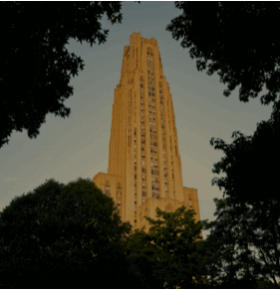
Subscribe to Pittwire Today
Get the most interesting and important stories from the University of Pittsburgh.University of Pittsburgh at Bradford sophomore Patrick Ianiro has been working on his medical school application resume since he was in high school. His latest entry is publishing with Assistant Professor Ryan Myers in the Journal of Physical Chemistry B.
Ianiro joined Myers’ international research project, which, with researchers in Pennsylvania and Japan, required some 11 p.m. meetings to account for the time difference.
Myers and his colleagues at Penn State and Okayama University were researching how two common ions, or electrically charged molecules, behave when they are near the surfaces of certain polymers, large molecules with repeating sequences that form synthetic substances like plastics or DNA. The researchers wanted to see whether the ions tend to stick to the polymers or prefer to stay part of the water.
The polymers they used change behavior with temperature. Researchers adjusted the water’s acidity and measured the temperatures at which the polymers’ molecules stopped dissolving and started clumping together. This required many variations of the same procedure with one variable changed slightly each time.
That’s where Ianiro came in.
“Pat made a lot of solutions for me and monitored them,” Myers said. “He was making an impact on a paper published in a very prestigious journal.” Ianero’s work checked the researchers’ initial findings before Myers interpreted the data.
This kind of tedious work is often the first step for undergraduate researchers — but it requires high precision and allows students like Ianiro to develop solid lab skills that they can build on in the future.
The ions tested, hydronium and hydroxide, are commonly used in medicine, materials science and chemistry, Myers explained. Knowing how they affect common plastics at different strengths and temperatures is important knowledge for people who work with those materials.
“This was a multi-university collaboration,” Myers said. “Being able to do that at such as small school does not happen very often.”
Myers himself attended a small undergraduate institution — Seton Hill University in Greensburg, Pennsylvania — and wanted to teach at a small university, where he could have the kind of impact on his students that his mentor did on him. In earning his doctorate at Penn State, Myers said his goal was to teach undergraduate students.
“Getting to see students learn and like something that they didn’t used to like, that makes me feel like I did something,” Myers said.
Ianiro knew he liked chemistry, and he chose to begin his college career at Pitt’s Bradford campus to have such opportunities as research. Another opportunity he has pursued to build his medical school resume is volunteering with a local emergency medical service, made possible by an EMT course at Pitt-Bradford that allowed him to become certified.
As if that were not enough, Ianiro also spends many hours each week working on his charity, The Silent Strength Corp., of which he is president and CEO. As a high school student in his hometown of Doylestown, Pennsylvania, he tutored other students and became aware of the gang violence in his area. He founded the charity to conduct and examine research on the mental health of young men. As with other things he does, Ianiro did not think small, incorporating his charity and partnering with restaurants in Miami for a spring break fundraiser to support the organization’s goals.
The next step toward his goal of becoming a surgeon is a transfer to the university’s Pittsburgh campus, but Ianiro said he’s glad he chose to begin his journey at Bradford.
“When I was looking at colleges, I visited the Pittsburgh campus, and while it had a lot of resources, the environment felt different,” he said. “I thought Pitt-Bradford was a better starting point for my education because it minimized distractions and allowed me to focus on my studies.”
Photography by Glenn Melvin


